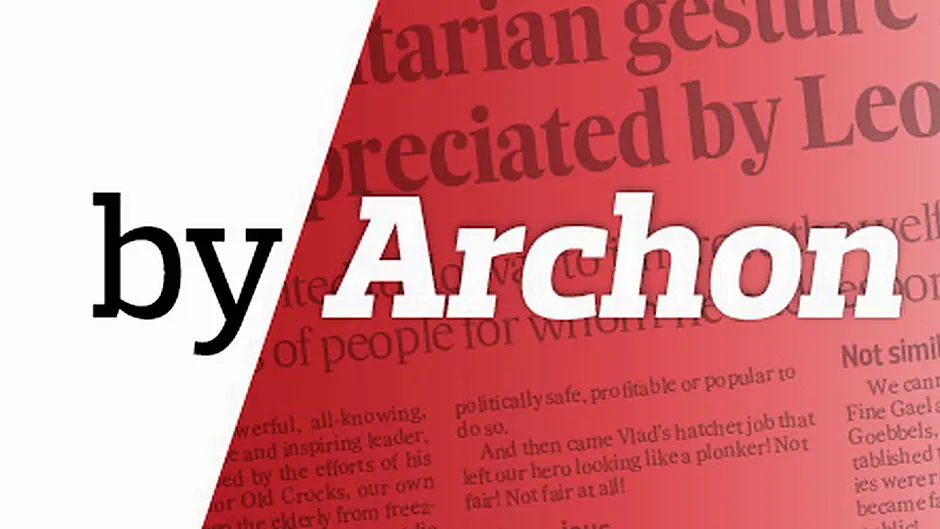Shakespearean shenanigans that took place on stage touched a chord with observers of Irish public life
THE comedy ‘A Mad World my Masters’, popular in Shakespeare’s time, was performed not too long ago in London. Stuffed to the gills with characters such as Sir Bounteous Peersucker, Mr Follywit, Penitent Brothel and Mrs Littledick, the play was updated to a cynical and amoral view of life in London ‘where glamour and politics rub up against filth, and everyone loves it’.
Interestingly, the shenanigans that took place on stage touched a chord with observers of Irish public life and, in the process, reinforced the sense of ‘unsureness’ that is experienced whenever an effort is made to make sense of the jumbled, off-the-wall announcements made by government politicos.
For instance, last week elements of the meeja jumped up and down in excitement when reporting a political slump in the polls for Fine Gael. A commentator quickly attributed the decline in support to a statement purporting to come from Simon Coveney. He revealed that the Tánaiste had been toying with the idea of holding a State-endorsed commemoration of the Black and Tans!
Problem was, Coveney never made such a preposterous statement! He had done nothing more than muse on the controversy surrounding his party’s handling of a possible commemoration of the Royal Irish Constabulary (RIC), and whether his musings were responsible for FG’s poor performance in a recent poll. Simply put, he had the RIC on his mind, not the Black and Tans!
IRISHNESS OF RIC
And that was interesting, because, in one respect, a State commemoration of the RIC would be an acknowledgement of the fact that Fine Gael’s strategy of ‘peace and reconciliation’ now formed an integral part of normal political discourse.
Indeed such a way of seeing things would help get across the FG point that the primary function of the RIC had been to ‘maintain public peace and order, to enforce laws, and to prevent crime in Ireland’ for a lawful government (British).
Needless to say, the argument was difficult to swallow for those who saw the Royal Irish Constabulary as an outfit that did its utmost to obstruct independence for Ireland.
Yet, it has to be remembered that the RIC never expressed a word of disloyalty to the Crown, neither during the War of Independence nor when the force was supplemented by 8,000 Black and Tan scum and later by an elite cadre of murderers, the Auxiliaries.
Which makes Mr Coveney’s reasons – whatever they are – for endorsing a proposal to ‘commemorate’ an alien police force all the more intriguing!
Interesting, too, that attention has rightly focussed on the RIC’s ‘Irishness’ and that the police force attracted 90,000 Irishmen to its ranks between 1836 and 1922 – mostly Catholic and from the labouring and farming classes.
DEPRAVITY
As a well-trained, para-military force which was armed with revolvers, bayonets, rifles and truncheons, it earned the contempt of Irish nationalists for its actions during the Tithe War (1830-1836), the Young Ireland Rebellion (1848), the Fenian Rising (1867), the Land Wars (1879 -1882; 1886-1891) and the War of Independence (1919-1921). And, of course, we should not forget the Dublin version of the force, known as the DMP, which was despised for the violence it used against strikers during the 1913 Lockout.
After 1922, the RIC was replaced by An Garda Síochána in the south and, in the six counties, by the Royal Ulster Constabulary.
Importantly, despite its ‘Irishness’, the RIC certainly was not a collection of Constable Plods! An idea of the depravity to which it could sink is evident in the comments of Lt Colonel Gerald Smyth when he advised recruits to shoot ‘rebels’ without hesitation: ‘If the person approaching a patrol has their hands in their pockets, or are in any way suspicious, open fire. You may make mistakes occasionally and innocent persons may be shot, but that cannot be helped, and you are bound to get the right parties sometime’. To their credit, several RIC men immediately resigned in disgust.
All of which prompted a Leesider in the Cork Arms to ask ironically what Coveney might do for the next stage of the controversy: rename St Patrick’s Street as Black-and-Tan Boulevard in honour of the contribution the Tans made to urban planning? Harsh, but he had a point!
RULE BRITANNIA?
Was it with a sense of glee that EU officials informed Britain’s Brexit Party that there would be no ceremony in the European Parliament to ‘commemorate’ British withdrawal from the EU? The looney toons had sought a potentially dramatic scene against the midnight sky to accompany the lowering of the Butcher’s Apron (or Union Jack) on January 31st.
Instead they were told the flags would be removed at an unconfirmed time, one to be sent to an EU-funded museum in Brussels called the House of History. Its artefacts range from ancient objects depicting Greek myths to copies of Brexit referendum promises which, amusingly, already have been classified as another type of myth!
The British MEPs were expected to do the decent: clear their offices and return equipment such as iPads. Many of them got a bit of a shock when told they were not entitled to a redundancy payment as they had served for less than a year.
MARY HARNEY’S BUST
Cork Institute of Technology got its knickers in a knot at the outcry it provoked a few years ago by commissioning paintings of its president and the then chair of its governing body at a cost of €20,000. A further €2,214 was spent on framing the portraits.
At the time, the college was carrying a €1m deficit.
And now another controversy has erupted in the groves of academe. This time at the University of Limerick where Mary Harney (remember her, the PDs, and all that nightmare?) is the current chancellor.
She’s to be ‘commemorated’ by a stone bust, to be paid for entirely by the university!
Cost to the cash-strapped college, our money, which is supported by the State? They won’t say as ‘such matters are commercially sensitive’. Oh, a State secret! Strictly classified, privileged info, confidential and restricted! That’s OK, then!
And the artist? Welll, that’s a secret too!
Subscribe to the Southern Star's YouTube channel, like us on Facebook and follow us on Twitter and Instagram for all the latest news and sport from West Cork.







